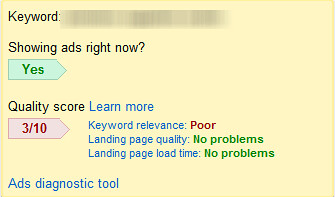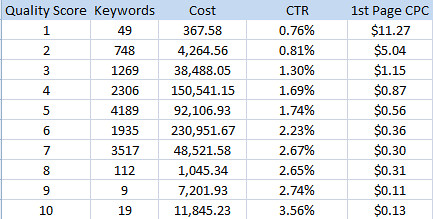Is Google Changing Quality Score Rules Again?
In the past few months, two significant issues have been messing with AdWords quality scores—or at least with how many of us perceive quality scores. Google has developed several bugs in how it displays quality score. Keywords with low quality scores are acting like keywords with high quality scores. Google Quality Score Display Bugs Google’s […]
In the past few months, two significant issues have been messing with AdWords quality scores—or at least with how many of us perceive quality scores.
- Google has developed several bugs in how it displays quality score.
- Keywords with low quality scores are acting like keywords with high quality scores.
Google Quality Score Display Bugs
Google’s quality score bugs have been well documented.
I’ve seen reports of quality score in AdWords accounts not matching what’s being displayed in the AdWords editor. There are other reports of the quality score in the account not being accurate, etc. For the purposes of this article, these glitches are not an issue. Google engineers checked on several accounts and assured us that the quality score display bugs are not affecting the actual performance of these accounts.
How Quality Score Affects Ad Display
When a keyword has a low quality score, several ad features stop working:
- Ads are not displayed in the premium positions (above the organic results).
- Sitelinks cease to work.
- Product extensions do not work.
- Dynamic keyword extension stops working.
Other features stop working as well until you finally receive the message that the ad is not being displayed due to low quality score.
Low Quality Score Keywords Eligible to be Displayed
In the past, keywords with quality scores of 3 were generally given the error that the keyword was not being displayed due to low quality score. Keywords with a quality score of 4 or higher rarely received this warning.
That number seems to have been lowered. Keywords with quality scores of three now seem to be eligible to be displayed on all results.
While these keywords still show a poor relevance, they are being displayed not just on the search results, but in premium positions.
Low Quality Score Keywords In Top Positions
Until a few months ago, I cannot recall having a keyword with a 3 quality score regularly displayed in the top positions above the search results. Google states that ads have to meet minimum quality and CPC thresholds to be displayed in the top positions. The ads above the search results have always been held to a higher standard than other ads displayed in the right rail.
However, that seems to be changing. Low quality score keywords are being displayed in the coveted top positions.
In Google Analytics, you can see your clicks by keyword position. This screenshot is for a keyword with a quality score of 3.
Across several accounts, there are many instances of keywords with quality scores of 3 or 4 being displayed in the premium positions.
Static CPCs & Average Positions
Ad Rank is determined by multiplying your max CPC by your quality score. Google usually shows the keyword with the highest ad rank in the first position, with the rest of the ads displayed in declining order of ad rank.
Ad rank determines your position, and is comprised of your max CPC and quality score. Therefore, if your quality score decreases, your CPC should go up or your average position should go down. Often, it will be a combination of both.
For this keyword, there are several pages of advertisers, so competition can sometimes skew charts like this.
This particular keyword had a slow decline in quality score over a few months. However, even while ad rank declined, average position and CPCs changed very little.
It is possible that the other bidders influenced this by lowering their bids. Another possibility is that the entire industry had declining quality scores on this keyword; hence, the fairly static average position even though ad rank fell.
CTR Still Rules Quality Score
There are many factors that go into creating each keyword’s quality score. However, CTR has always been the most important one (assuming your landing page is good).
As CTR goes up, first page bids go down and quality score goes up. This was particularly evident in this particular account.
When trying to raise your quality score, testing ad copy for an increase in CTR is one of the best ways to start.
Quality Score Is Still Google’s Opinion
Over the past few months, quality score seems to be going through a metamorphosis. Low quality score keywords are acting like high quality score keywords, and this phenomena is not isolated to a handful of accounts. I’ve heard dozens of stories, and see more examples of this happening in the past few months that I’ve heard in the past five years since quality score was introduced.
When you are optimizing for quality score, you are optimizing for Google’s automated opinion about how good the experience a searcher will have with your company will be.
You should always temper your quality score optimization by looking at which combination of ads and keywords bring your account more profits. You might choose to keep a lower quality score ad copy and keywords combination because it has higher profits than the high quality score combination. Nonetheless, if your quality scores are dropping, you shouldn’t ignore the trend.
Just remember, optimizing for quality score is optimizing for Google’s opinion. Optimizing for ROI keeps your company in business.
Opinions expressed in this article are those of the guest author and not necessarily Search Engine Land. Staff authors are listed here.
Related stories
New on Search Engine Land



